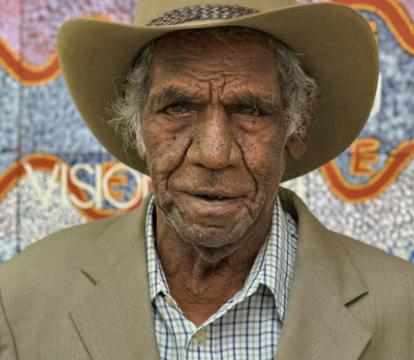A Possum Story
Michael Jagamara was born into and revelled in a time of great change and opportunities. Following the end of World War II, abstract expressionism had arrived in the Australian art world and Sidney Nolan completed his Ned Kelly series. Also in that year, in the north part of Western Australia, in an amazingly unread, event, at least 800 Aboriginal pastoral workers walked off the job and began one of the longest industrial strikes in Australian history.
Jagamara traveled widely in the Northern Territory and began to paint as a second generation Papunya artist. I had heard a lot about him but first met him at the 1986 Biennale of Sydney: Origins, Originality, and Beyond. He’d already completed his beautifully balanced, layered Five Stories masterpiece painting by then. I remember him as warm, open and friendly and our travelling group bonded with him. The artists Jimmy Djelminy and George Milpurrurru from the Ramingining Performance Group spent an evening in song with him despite language differences at the residence of Marianne Baillieu Myer.
In the Aboriginal world, two often-anthropomorphised animal spirits are the dingo and the possum. The dingo is seen in some terms as lawless — a being who sleeps with anyone. Men in Arnhem Land jokingly say to each other “nhe watu”, literally, “you dog”. A canine is a wild animal that is controlled and domesticated. How do you domesticate a wild animal? By feeding it, making it, and keeping it dependent? A dog on a leash: many of us First Peoples have felt constantly reminded of the length and limits of this leash.
In nearly every account of the colonial frontier is a yearning description of the extreme loneliness of life here, away from their kind (for white colonial people), especially for women. In 1813, Edward Orme published Field Sports of the Native Inhabitants of New South Wales in London containing the images of John Heaviside Clark (c.1770 - 1863). These images showed Aboriginal people of the Sydney area cutting footholds and climbing trees to hunt possums. The paintings of Joseph Lycett (1775-1828) also showed images of Aboriginal people in possum hunting activity. Neither of these colonial western artists were moved to see possums as sentient beings, equivalents to humans. A tree trunk from Tumbalong (the place where seafood is found, Darling Harbour), dated to the 1830s, from the Australian Museum collection, is on display at the Museum of Sydney. It is marked with foot holes to assist in climbing the trunk to hunt possums. First peoples hunted possums to eat and to use their skins to make fur-skin cloaks and, I would dare say, still sang and talked on them. First Peoples hunted these possums up to the present day for food. Dingoes or possums are now rarely painted by southeast Aboriginal artists (in the case of the latter most probably not eaten or talked to either) but in other parts of Australia, as in Jagamara’s Opera House masterpiece, they are venerated, sung and danced about with intense feeling, and seen as greatly influential to human society.
Possums, as totemic animals, are sexy beasts in Aboriginal spiritual terms. They stay up at night, are playful, furry, cuddly, mischievous, noisy, cheeky, athletic and full of life. Jagamara’s mural is prescient in its subject matter, full of the spirit of place, and powerfully appropriate on this site, the cultural performance space on Tubogowle. A space of sonic resonance where possums play.
Read more about Michael Nelson Jagamara and Possum Dreaming.
